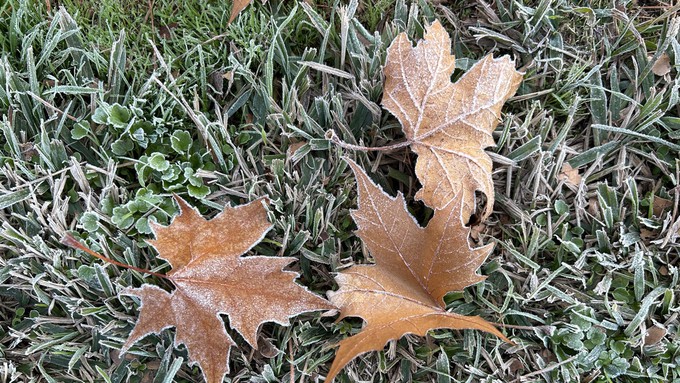
Be prepared to chill: Frosty mornings return to Sacramento forecast

Saturday morning was plenty cold, with delicate frost patterns on fallen leaves and lawns. Prepare the garden for more frost through at least Thursday. Kathy Morrison
Clear skies have returned over Sacramento and so has the threat of frost.
According to the National Weather Service, “patchy frost” or “areas of frost” is in the forecast every morning Saturday through at least Thursday, with overnight lows dipping into the mid to low 30s. Most mornings, there will be just enough wind to make it feel like freezing – 32 degrees.
Daytime highs will actually be on the “warm” side – 60 to 62 degrees Monday through Friday. Average for this week in December: 54 degrees.
That chill will bring down many remaining fall leaves. Take advantage of these dry but crisp conditions. It’s time to get out the rake!
* Rake leaves away from storm drains and keep gutters clear.
* Fallen leaves can be used for mulch and compost. Chop up large leaves with a couple of passes with a lawn mower.
* Prune non-flowering trees and shrubs while they’re dormant. Without their foliage, trees are easier to prune.
* Rake and remove dead leaves and stems from dormant perennials.
* Make sure to take frost precautions with new transplants and sensitive plants. Mulch, water and cover tender plants in the late afternoon to retain warmth.
* Succulent plants are at particular risk if temperatures drop below freezing. Don’t water succulents before frost; cover instead. Use cloth sheets, not plastic. Make sure to remove coverings during the day.
* Clean and sharpen garden tools before storing for the winter.
* Brighten the holidays with winter bloomers such as poinsettias, amaryllis, calendulas, Iceland poppies, pansies and primroses.
* Keep poinsettias in a sunny, warm location. Water thoroughly. After the holidays, feed your plants monthly so they'll bloom again next December.
* Just because it rained doesn't mean every plant got watered. Give a drink to plants that the rain didn't reach, such as under eaves or under evergreen trees. Also, well-watered plants hold up better to frost than thirsty plants.
* Plant garlic (December's the last chance -- the ground is getting cold!) and onions for harvest in summer.
* Bare-root season begins. Plant bare-root berries, kiwifruit, grapes, artichokes, horseradish and rhubarb. Beware of soggy soil. It can rot bare-root plants.
Comments
0 comments have been posted.Sacramento Digs Gardening to your inbox.
Sites We Like
Garden Checklist for week of July 21
Your garden needs you!
* Keep your vegetable garden watered, mulched and weeded. Water before 8 a.m. to reduce the chance of fungal infection and to conserve moisture.
* Feed vegetable plants bone meal, rock phosphate or other fertilizers high in phosphate to stimulate more blooms and fruiting. (But wait until daily high temperatures drop out of the 100s.)
* Don’t let tomatoes wilt or dry out completely. Give tomatoes a deep watering two to three times a week.
* Harvest vegetables promptly to encourage plants to produce more. Squash especially tends to grow rapidly in hot weather. Keep an eye on zucchini.
* Pinch back chrysanthemums for bushy plants and more flowers in September.
* Remove spent flowers from roses, daylilies and other bloomers as they finish flowering.
* Pinch off blooms from basil so the plant will grow more leaves.
* Cut back lavender after flowering to promote a second bloom.
* It's not too late to add a splash of color. Plant petunias, snapdragons, zinnias and marigolds.
* From seed, plant corn, pumpkins, radishes, winter squash and sunflowers.